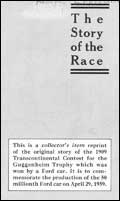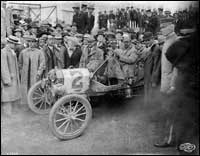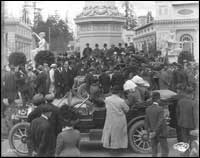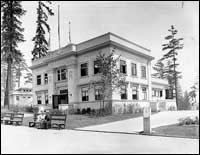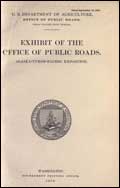|
Automobile raceAbout the race Because of the lack of roads (particularly west of the Mississippi), participants went west to Chicago, south to St. Louis, on to Denver, and then up through Wyoming, Idaho, and across Washington. Automobiles were still a new technology in 1909 and many people considered cars too dangerous to be on city streets. Because of the concerns about speed, the organizers divided the Ocean to Ocean race into two events, an endurance run from New York City to St. Louis and a speed race from St. Louis to Seattle. East of the Mississippi, driving was only permitted during daylight and only at legal speeds. West of St. Louis, the rules were wide open. The Auto Club believed the western roads were so bad that speed law violations would be impossible. The Pace or Pathfinder car, preceded the racers in order to select the best routes. The famous Thomas Flyer, winner of the 1908 New York to Paris race, was used as the Pathfinder. When the Thomas Flyer car took two months to cross the country, it was clear that the roads along the way were in bad shape. Robert Guggenheim donated the transcontinental trophy and the prize money for the race. The winner received the trophy and $2,000. Second prize was $1,500. Inscribed with: "Alaska-Yukon Automobile Race Guggenheim Trophy New York to Seattle," the trophy has small figureheads of Chief Seattle at its base, and pictures of the Agriculture Building and a view of Seattle's main street near its top. About the race winners and conditions Five months after the race (and after the close of the AYP), the Model T was disqualified for breaking race rules for changing engines part way through the race. The second place finisher, a Shawmut, was declared the new winner. In the meantime Henry Ford used the victory to help advertise and market the Model T. The roads were bad west of the Mississippi. H.B Harper, one of the participants for Ford, wrote, “every day we wore rubber coats and hip boots and pushed through mile after mile of mud.” Thirty-five miles outside of Denver, both Fords mired in quicksand. Harper said, “with the aid of the roof of a deserted pig pen which. . . we shoved under the wheels. . . we got both cars out and made Denver.” The worst part of the trip for the winning car was over Snoqualmie Pass. The racers crossed Lake Keechelus by ferry at five in the afternoon then floundered in snow in the Pass. They reached the summit at 8pm and went on for another hour and a half. After sleeping for a while, they started out again at 2:30AM. The drivers noted that “in many places we had to dig our way out of the snow and practically climb over logs which lay across the road.” “Besides the snow there were steep grades, and it was pushing pulling, holding back, and digging all the way through the fifty miles.” About Good Roads building The Good Roads building was used for various purposes until it was destroyed by fire in 1961. Items from other institutions: |



